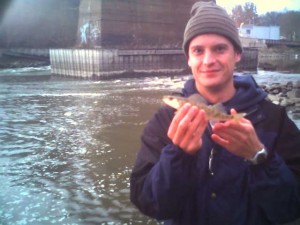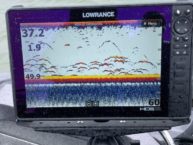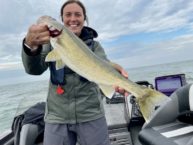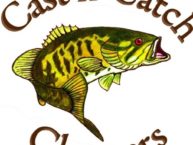Okay…maybe not the tiniest but it’s certainly the smallest I’ve ever caught. The picture also perfectly features an easy lesson in catching fish in a typical river setting. The shot was taken under the railroad bridge in between West Burlington and West Benton Street in Iowa City. In the background you can see where the river falls over the rocks into deeper water. Much like putting your thumb over the end of a hose, the concrete pylons that support the bridge increase the velocity of the passing water. This increased force of this high flow results in deep scour holes immediately below the mouths of where the water exits. The rocky debris that is dug out by the water is fanned over the river bottom just beyond the hole and this is called a riffle. Walleyes and other species like catfish will frequently use these holes as home base when they’re not out hunting prey. The water is deeper, cooler, and when the time is right they have several opportunities to choose from when looking for an easy meal. When the high velocity water (or “quick” water) makes it beyond the bridge it will meet slower (or “slack”) water on either side creating a visible seam in the river. Walleyes and bass will take advantage of this situation by waiting in the slack water for disoriented prey to come tumbling through the faster current. The more aggressive fish (but not always the largest) can be found up closer to the opening where the fastest water typically hits the slowest but fish can be found all along the seam farther back down river. Fish can also be found just beyond the scour hole along the rock riffle. Again, waiting to ambush emerging prey.
When the water level is high in the spring and summer months and the seam is more pronounced a jig and a minnow pitched just right so that it flows down river while you slowly pick up the slack so that strikes can be detected is a common technique. A lot of walleye fisherman on the river use this method and can’t be convinced to try anything else. Incorrectly concluding that lighter is always better, you’ll frequently spot these walleye fisherman tying on the smallest jig heads they can find and casting out minnows that even a bluegill would have a hard time going for. Don’t get set in your ways. An over-looked technique is to use a slip bobber rig and cast it up at the top of the seam and let it gently float down river. Cast a crank. River walleyes are sturdy fish that are used to having to compete for dinner so never assume that they’re a dainty species looking for the most delicate offerings. If you can accurately assess the depth and can resist the temptation to go for the deep diver you can catch a lot of walleye on shallow running Husky Jerks, Reef Runners, Frenzy Firestick Minnows, Thundersticks and Rattlin’ Rogues. During the autumn months I’ve had terrific luck on this very spot casting jointed Shad Raps in GFR color out across the rock riffles at dusk.
And the big secret? The walleye in the picture was taken on a night crawler and split shot rig cast into the bottom of the scour hole. Use the same method and you might just get a six incher of your own to brag about!





4 comments for “World’s Tiniest Walleye (and a good lesson in river fishing!)”